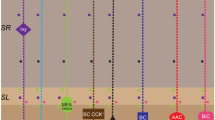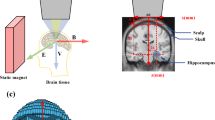Abstract
Astrocytes as well as electromagnetic induction have been primarily considered as main factors in regulating neuronal firing patterns in the recent decade. In this work, an improved neuron-astrocyte model in consideration of the modulation of astrocytes and the electromagnetic induction is employed to explore the extend to which both of the factors affect the firing modes of the neurons. The “alternation mode”, defined as the alternative of neural normal spiking mode with the high-frequency bursting-like mode, clearly shows the functions of astrocytes on neurons. Moreover, the firing pattern of the neuron becomes more abnormal when astrocytes are hyper-excitable, the reason why the abnormal coupling of the astrocyte leads to the “alternation mode” of the neuron have been studied. In addition, the effect of electromagnetic induction manifests nonlinear characteristic towards neurons, complex firing modes of neurons are observed in the weaker field and a switching mode consists with quiescent and spiking mode appears when there is a higher stronger field. This approved model can reveal the normal or abnormal electric activities of neuron considered electromagnetic induction induced by the degree of excitability of the astrocyte. These results can provide potential understanding about the effects of astrocyte on neuronal activity when the coupling of electromagnetic field is considered.














Similar content being viewed by others
References
Barry JF, Turner MJ, Schloss JM et al. (2016) Optical magnetic detection of single-neuron action potentials using quantum defects in diamond. Proceedings of the National Academy of Sciences 113(49), 14133–14138
Du MM, Li JJ, Chen L et al (2018) Astrocytic channels and gap junctions account for spontaneous epileptic seizure. Plos Computational Biology 14(3):e1005877
Fan D, Zheng Y, Yang Z et al. (2020) Improving control effects of absence seizures using single-pulse alternately resetting stimulation (SARS) of corticothalamic circuit. Applied Mathematics and Mechanics 41(9), 1287–1302
Feng P, Wang R, Wu Y (2020) Critical behaviors of regular pattern selection in neuronal networks with chemical synapses. New Trends in Nonlinear Dynamics pp 163-171
Fitzhugh, R (1960) Thresholds and plateaus in the hodgkin-huxley nerve equations. The Journal of General Physiology 43(5), 867–896
Guan L, Gu H, Jia Y (2020) Multiple coherence resonances evoked from bursting and the underlying bifurcation mechanism. Nonlinear Dynamics 100(4), 3645–3666
Guan L, Gu H, Zhao Z (2021) Dynamics of subthreshold and suprathreshold resonance modulated by hyperpolarization-activated cation current in a bursting neuron. Nonlinear Dynamics 104(1), 577–601
Hindmarsh JL, Rose RM (1982) A model of the nerve impulse using two first-order differential equations. Nature 296(5853), 162–164
Hodgkin AL, Huxley AF (1952) A quantitative description of membrane current and its application to conduction and excitation in nerve. The Journal of physiology 117(4):500–544
Laura MC, Juan CS, Jorge OI et al. (2019) Connexins-Based Hemichannels/Channels and Their Relationship with Inflammation, Seizures and Epilepsy. International Journal of Molecular Sciences 20(23):5976
Lines J, Martin ED, Kofuji P et al. (2020) Astrocytes modulate sensory-evoked neuronal network activity. Nature Communications 11(1):3689
Liu Y, Ma J, Xu Y, at al, (2019) Electrical mode transition of hybrid neuronal model induced by external stimulus and electromagnetic induction. Int J Bifurcation and Chaos 29(11):1950156
Li JJ, Tang J, Ma J et al. (2016) Dynamic transition of neuronal firing induced by abnormal astrocytic glutamate oscillation. Scientific Reports 6:32343
Lv M, Wang C, Ren G et al. (2016) Model of electrical activity in a neuron under magnetic flow effect. Nonlinear Dynamics 85(3), 1479–1490
Ma J, Tang J (2017) A review for dynamics in neuron and neuronal network. Nonlinear Dynamics 89(3), 1569–1578
Mondal A, Upadhyay RK, Ma J, Yadav BK, Sharma SK, Mondal A (2019) Bifurcation analysis and diverse firing activities of a modified excitable neuron model. Cognitive Neurodynamics 13(4), 393–407
Morris C, Lecar H (1981) Voltage oscillations in the barnacle giant muscle fiber. Biophysical Journal 35(1), 193–213
Nadkarni S, Jung P (2003) Spontaneous oscillations of dressed neurons: A new mechanism for epilepsy? Physical Review Letters 91(26):268101
Postnov DE, Ryazanova LS, Brazhe NA et al. (2008) Giant glial cell: New insight through mechanism-based modeling. Journal of Biological Physics 34(3–4), 441–457
Roth BJ, Wikswo JP (1985) The magnetic field of a single axon. A comparison oftheory and experiment. Biophysical Journal 48(1):93–109
Verisokin AY, Verveyko DV, Postnov DE et al. (2021) Modeling of Astrocyte Networks: Toward Realistic Topology and Dynamics. Frontiers in Cellular Neuroscience 15:645068
Wang, S S (1995) The lifetime of inositol 1,4,5-trisphosphate in single cells. Journal of General Physiology 105(1), 149–171
Wang YH, Wang RB, Zhu YT (2017) Optimal path-finding through mental exploration based on neural energy field gradients. Cognitive Neurodynamics 11(1), 99–111
Wang RB, Wang ZY, Zhu Z (2018) The essence of neuronal activity from the consistency of two different neuron models. Nonlinear Dynamics 92(3), 973–982
Wu F, Ma J, Zhang G (2020) Energy estimation and coupling synchronization between biophysical neurons. Science China Technological Sciences 63(4), 625–636
Yuan ZX, Feng PH, Du MM, Wu Y (2020) Dynamical response of a neuron-astrocyte coupling system under electromagnetic induction and external stimulation. Chinese Physics B 29(3):030504
Yu YY, Yuan ZX, Fan YC et al. (2020) Dynamic transitions in neuronal network firing sustained by abnormal astrocyte feedback. Neural Plasticity 2020:8864246
Zhang XH, Liu SQ (2019) Stochastic resonance and synchronization behaviors of excitatory-inhibitory small-world network subjected to electromagnetic induction. Chinese Phys B 27(4):040501
Zhang Y, Xu Y, Yao Z et al. (2020) A feasible neuron for estimating the magnetic field effect. Nonlinear Dynamics 102(3), 1849–1867
Zhan F, Liu S (2019) A Henon-like map inspired by the generalized discrete-time FitzHugh-Nagumo model. Nonlinear Dynamics 97(4), 2675–2691
Zhu FY, Wang RB, Pan XC (2019) Energy expenditure computation of a single bursting neuron. Cognitive Neurodynamics 13(1), 75–87
Author information
Authors and Affiliations
Corresponding author
Ethics declarations
Conflict of interest
The authors declare that they have no conflict of interest.
Additional information
Publisher's Note
Springer Nature remains neutral with regard to jurisdictional claims in published maps and institutional affiliations.
Project supported by the National Natural Science Foundation of China (Grant No. 11272242 and Grant No. 11972275) and China Postdoctoral Science Foundation (Grant No. 2018M631140).
Rights and permissions
About this article
Cite this article
Yuan, Z., Feng, P., Fan, Y. et al. Astrocytic modulation on neuronal electric mode selection induced by magnetic field effect. Cogn Neurodyn 16, 183–194 (2022). https://doi.org/10.1007/s11571-021-09709-7
Received:
Revised:
Accepted:
Published:
Issue Date:
DOI: https://doi.org/10.1007/s11571-021-09709-7




